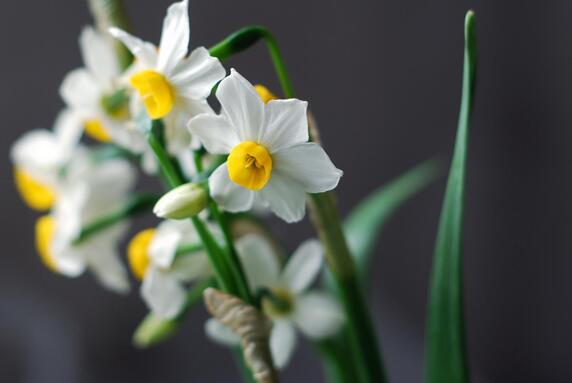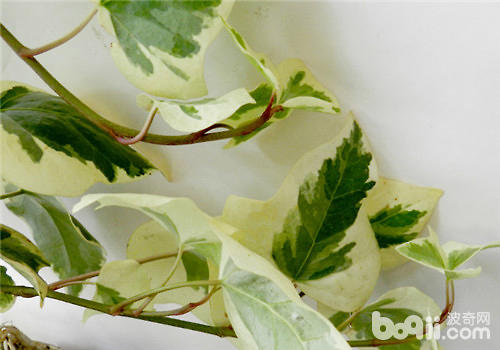How to propagate and cultivate ivy?
Ivy leaves vary, color is rich in change, coupled with plant delicate, elegant posture, often hanging cultivation layout in front of windows, a few shelves and cabinets, is a rare indoor hanging beautification plant materials. Ivy originated in Europe, especially in England, like warm and humid environment, suitable growth temperature of 20~25℃, 35℃ above the yellow leaves stop growing. It can adapt to a wide range of light, should be semi-shade, but also shade tolerance, in full sunlight conditions can also grow, more cold-resistant than heat-resistant, but mosaic horticultural varieties cold-resistant poor, winter should not be lower than 5℃.
Ivy can be propagated by cuttage and layering. Cuttings in the growing season to take healthy shoots about 10 cm long, inserted into sand or soil, keep the soil moist and shade, 10 days or so rooting, easy to survive. The ivy cuttings in water is also very easy to survive. The layering is also very convenient. As long as the stem nodes of its branches are buried in another flower pot or soil, keep the soil moist, and soon the stem nodes will take root. Later, the poison will be cut off, and a new pot of foreign ivy propagation will be completed.
Ivy is easy to cultivate, the soil requirements are not high, potted 3 garden soil, chaff ash and sand each preparation can meet its normal growth needs. The flowerpot should be 12~15 cm in diameter, and 3~5 seedlings should be planted in each pot.
Cultivation in general let its natural growth, drooping fall, but also for its climbing column growth. In the seedling stage, in order to make the plant shape plump, head can be carried out to inhibit the flourishing of the main vine and promote branching. Old plants with fallen roots and leaves can be re-cut to promote new branches; or re-cuttage for plant renewal.
Ivy growth period should be placed near the window and other bright places, in the balcony and south windowsill placed on the Ivy, June to August to avoid direct sunlight. Although it is very resistant to shade, can be placed in any corner of the room, but sufficient light is more conducive to its growth. Especially some flower varieties, under sufficient light conditions, the branches are full and robust, the nodes are short and uniform, the leaves are thick, and the leaves are bright and bright. After entering April, with the increase of temperature, we should increase the amount of watering, keep the pot soil moist at ordinary times, not too dry, nor waterlogging. Summer high temperature season, on the growth of ivy adverse, often in a semi-dormant state, then in addition to shade, but also spray cooling, increase air humidity. After autumn, the amount of watering in the pot should be reduced, but due to the dry weather, it is necessary to spray water on the leaves frequently to maintain a certain air humidity. Ivy fertilizer requirements are not high, April to September 1 to 2 times a month organic fertilizer can be sprayed once a month 0.2% urea and potassium dihydrogen phosphate, can make the leaves more beautiful.
When the temperature drops to 15 ° C at the end of October every year, put the ivy indoors and take measures to ensure that the temperature is not lower than 5 ° C. Winter watering should be done without watering, otherwise it is easy to rot roots and die at low temperatures.
Ivy is vulnerable to scale insects in poorly ventilated environments, and it is necessary to improve the environment and remove overcrowded branches and insects by pruning to facilitate ventilation.
Key points of propagation and cultivation of ivy
Ivy, also known as foreign ivy, spring rattan, English ivy, is an evergreen woody vine belonging to the genus Ivy of Araliaceae. Climbing or creeping, up to 30 m long. It has aerial root climbing ability, but the adsorption ability of aerial root varies with varieties and environmental conditions. Leaves vary in size and shape, often 3-5-lobed on vegetative branches, entire or subentire; leaves on reproductive branches unlobed, narrowly ovate or subrhombic. Umbels globose, flowers white. Fruit globose, black at maturity.
Likes warm, moist and semi-shady environment and fertile, moist and well-drained soil. Drought tolerance is poor, not resistant to direct sunlight, but very resistant to shade, frost and dry climate. North can only potted, greenhouse winter.
Propagation can be used cutting or layering method, spring and autumn for seedling appropriate period, cut stem top or stem section, each section 3~4, cutting in river sand or humus loam, maintain humidity, accept sunshine about 50%~70%, about 1 month can root into seedlings. Another stem tendril cut wound, buried in the culture soil, to be vigorous growth of roots, and then cut off into new plants, this method is layering method.
Ivy soil requirements are not strict, cultivation to humus loam is better. But for potted plants, pot soil can be mixed by garden soil, 1/4 of plant ash and a small amount of base fertilizer. Plant ash is selected to keep the pot soil loose and breathable, and more potassium fertilizer can be used to meet the needs of ivy growth. Ivy in the growing season can be applied once every two weeks liquid fertilizer, or once a month granular fertilizer. For mosaic varieties, the proportion of nitrogen fertilizer should not be too high, lest the mosaic turn green. Green leaf ivy can grow under strong light and shade conditions; floral ivy cannot be exposed to sunlight for a long time in summer and autumn. Ivy in the spring when a large number of branches and leaves germinate, regardless of its flowers and leaves are placed in the sun, receive sufficient light, so that the branches and leaves will grow luxuriant, robust.
For column potted plants to often prune, pick the heart. Ivy should be most careful in plum rains and high summer temperatures. Plum season placed outdoors ivy, basin a ponding should be poured out in time, so as not to root for a long time by stains, rot. In summer high temperature season, it is best to choose early morning or evening watering, so as to avoid the difference between soil temperature and water temperature, causing the root system to be injured by reverse, and eventually leading to plant wither and death. Ivy in the case of high temperature or poor ventilation mites or aphids appear, generally available soapy water wash or spray 40% omethoate 1000~ 1500 times liquid can be.
Cultivation of ivy [Alias] Spring vine, ivy, creeper.
Hederahelix
[10] The five of them are [11].
[Configuration] Evergreen climbing vine, reddish brown wood. Leaves simple, alternate, leathery, often with milky white patterns, 3 - 5-lobed leaves on vegetative branches, ovoid or rhombic leaves on reproductive branches, entire. Inflorescences are globose, umbellate, yellow, autumn flowering, fruit ripening in May of the following year. There are more than 100 horticultural varieties. Common Phnom Penh, silver edge, white green, white veins, arrow leaves, tricolor, gold heart and other varieties.
[Habits] Originated in Europe, likes warm, humid, shade resistant, cold, not resistant to heat and high temperature, afraid of sun exposure. The soil requirements are not strict, like loose neutral and slightly acidic soil, more resistant to light alkali. Not resistant to drought and moisture.
[00:03: 14.140] The main reason for this is that it is the propagation of cuttings. Spring, summer and autumn can be carried out. Cut 20 cm stems when inserting, remove the lower leaves, insert 2~3 nodes of substrate, maintain humidity, and root quickly. It can also be propagated by curved branches and layering.
[Cultivation] can be planted in the shade of the courtyard or planted at the foot of the wall, can also be potted, with garden soil and rotten leaf soil mixed culture soil pot, every 2 years to change the pot 1. Summer needs shade, and pay attention to more watering and spraying, keep the leaves and pot soil moist. Usually can put flowers on a few seats or hanging basin, so that the stem tendril droop; can also tie beat or stand palm column, so that the stem tendril climbing upward.
[Usage] Land planting can be used for vertical greening. Potted plants for interior furnishings. Stems and leaves are used as medicine, with the effects of expelling wind, removing dampness, calming liver and detoxifying, and treating rheumatic arthritis, hepatitis and carbuncle swelling.
- Prev

What are the main diseases and insect pests of daffodils? How to prevent and cure?
The main diseases and insect pests are large brown spot (spot disease), rot, nematode disease, daffodil fly, acaroid mite and so on. The control methods are as follows: (1) from March to May, spray 700 times of 75% chlorothalonil wettable powder every 10 days, or 100 times of Bordeaux solution.
- Next

How to conserve ivy
Flower and leaf ivy is a cultivated variety of ivy. This new variety of variegated leaves prefers a humid and semi-overcast environment. The requirement of fertilizer is not high, and it can grow well even if it is not fertilized for a long time. However, if it is fertilized too much, it will grow rapidly and flourish, and the elegant flowers and leaves will disappear and show the common wild green leaves.
Related
- Fuxing push coffee new agricultural production and marketing class: lack of small-scale processing plants
- Jujube rice field leisure farm deep ploughing Yilan for five years to create a space for organic food and play
- Nongyu Farm-A trial of organic papaya for brave women with advanced technology
- Four points for attention in the prevention and control of diseases and insect pests of edible fungi
- How to add nutrient solution to Edible Fungi
- Is there any good way to control edible fungus mites?
- Open Inoculation Technology of Edible Fungi
- Is there any clever way to use fertilizer for edible fungus in winter?
- What agents are used to kill the pathogens of edible fungi in the mushroom shed?
- Rapid drying of Edible Fungi

